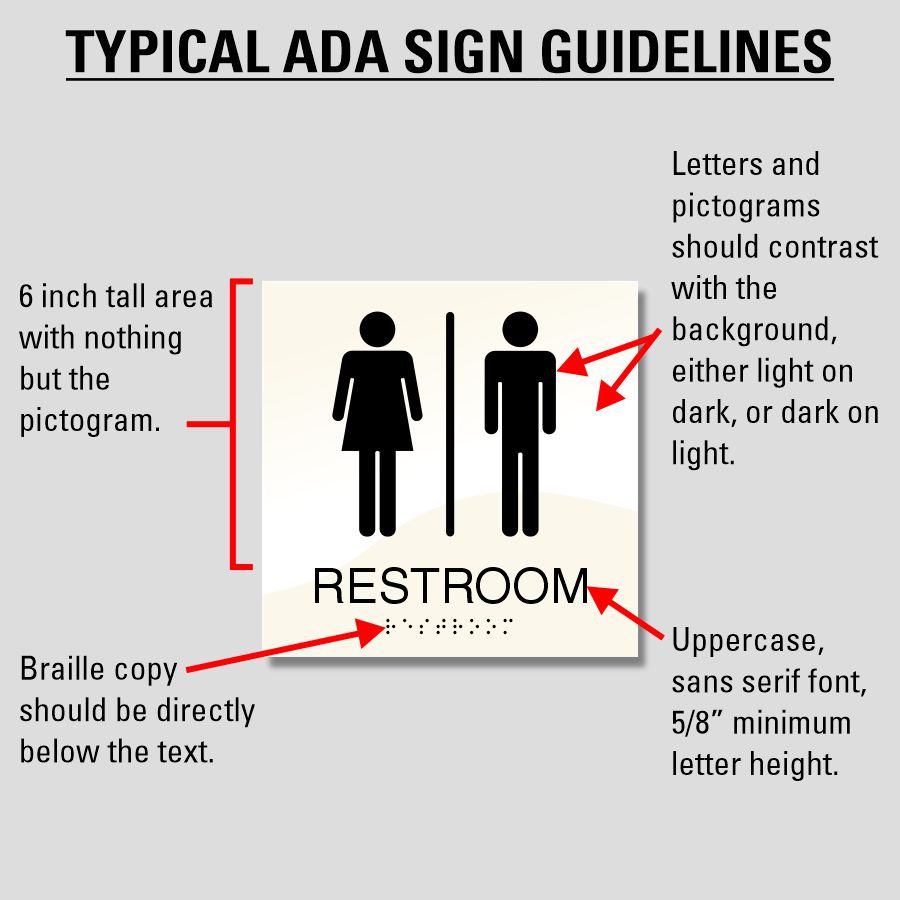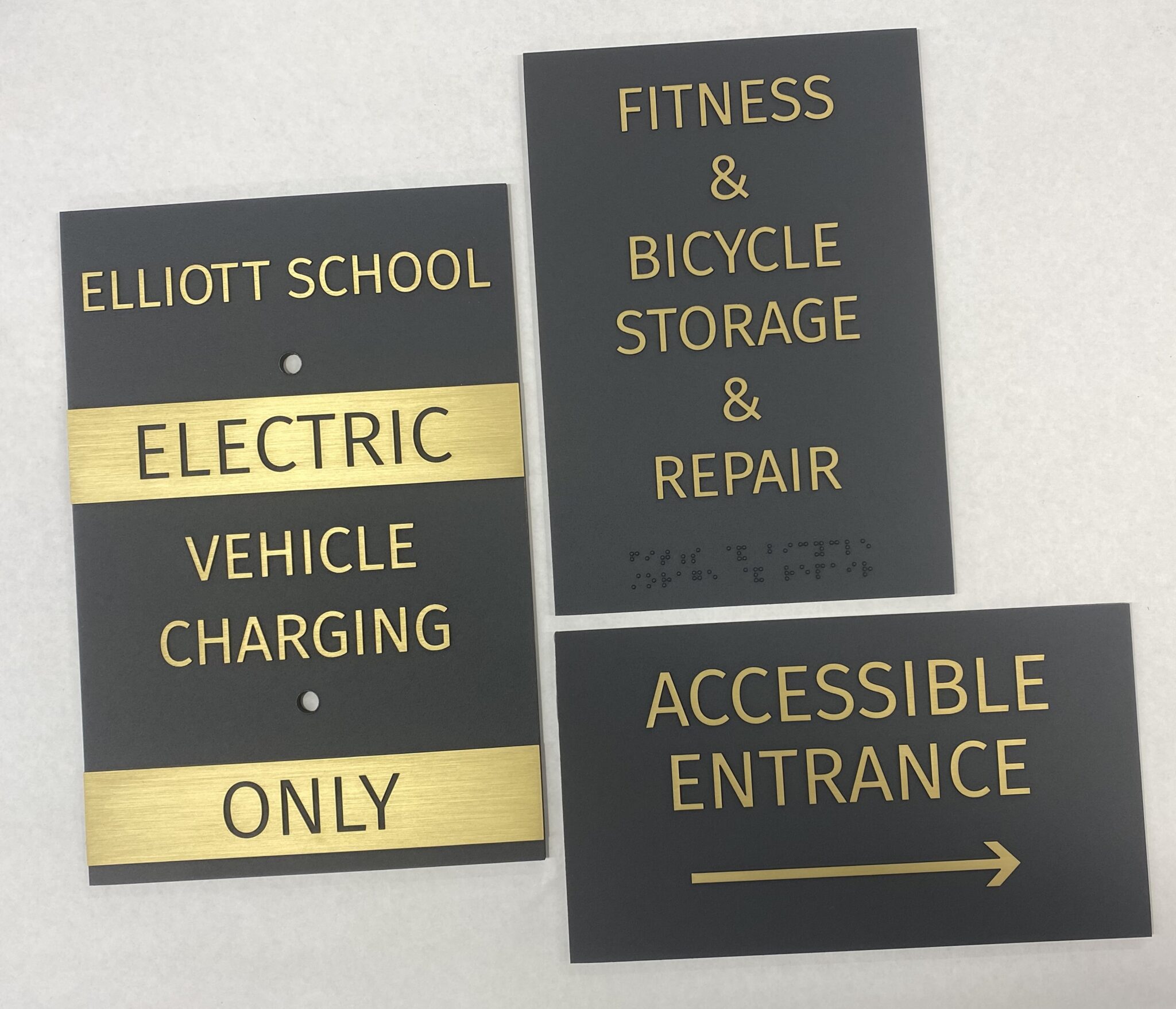The Impact of ADA Signs on Neighborhood Accessibility
The Impact of ADA Signs on Neighborhood Accessibility
Blog Article
ADA Signs: Ensuring Availability and Conformity in Public Spaces
ADA signage plays an essential role in guaranteeing accessibility and conformity within public rooms, substantially adding to an inclusive environment for people with handicaps. As we explore the subtleties of ADA signage, from responsive features to create complexities, it's crucial to consider just how these elements integrate to maintain the civil liberties of all customers.
Relevance of ADA Signage
In modern-day culture, the significance of ADA signage prolongs past plain compliance with legal requireds to symbolize a dedication to inclusivity and availability for all individuals. These indications are essential in producing environments where individuals with specials needs can browse public rooms with the exact same ease and freedom as those without disabilities. By supplying standard and clear details, ADA signage makes certain that everybody can access facilities, solutions, and info without obstacles.
The relevance of ADA signage hinges on its capability to enhance the lifestyle for individuals with impairments by advertising equivalent gain access to. It removes the barriers that might or else impede their ability to take part totally in neighborhood life. Additionally, these indicators work as noticeable signs of an organization's devotion to diversity and equal rights, showing more comprehensive societal worths that champion the civil liberties and self-respect of all individuals.
Additionally, ADA signage plays a critical function in public safety and security. By assisting people to exits, washrooms, and various other important centers, it ensures that all people, despite physical capacity, can evacuate safely throughout emergency situations. In recap, ADA signage is not just a regulative need but a powerful tool for fostering a inclusive and fair culture.
Crucial Element of Conformity

Placement is crucial; indicators have to be mounted in places that are conveniently noticeable and reachable. Typically, signage ought to be mounted in between 48 and 60 inches from the ground to make certain access for both standing and mobility device individuals. Tactile components, such as Braille, are important for individuals with aesthetic disabilities, supplying vital information in a non-visual style.
High-contrast colors between the message and history are required to enhance readability for people with reduced vision. The ADA mandates particular contrast proportions to make sure clearness. Additionally, personality size is a key factor to consider, with minimal height needs dictated by the viewing range to guarantee readability from various angles.
Layout Factors To Consider for Ease Of Access
Designing obtainable signage calls for a careful approach to guarantee it satisfies the needs of all individuals, particularly those with handicaps. This includes taking into consideration numerous style aspects that improve readability and use. Key factors consist of the option of typeface, color comparison, and tactile features. Typefaces ought to be sans-serif, with clear and simple letterforms, to facilitate simple analysis. The size of the message is equally important, with ADA guidelines suggesting a minimal height based on watching range to make sure readability.
Contrasting colors in between message and history are important for exposure, especially for individuals with aesthetic problems. A high comparison proportion aids distinguish the text from its background, improving readability under numerous lights problems. In addition, responsive components, such as Braille and elevated personalities, are vital for individuals who are blind or have reduced vision. These components need to be situated at a regular height and position to guarantee simple access and comprehension.
Additionally, the placement of signs plays a substantial duty in accessibility. Signs ought to be set up in places that are unhampered and easily obtainable. Guaranteeing that signs is placed at suitable elevations and angles makes it possible for all users, consisting of those using wheelchairs, to communicate with them properly.
Common Blunders to Stay Clear Of

One more common error is the incorrect placement of signs. ADA guidelines define accurate height and area demands to ensure that indications are easily visible and obtainable by all individuals, consisting of those using mobility devices. Neglecting these standards not just hinders ease of access yet also takes the chance of non-compliance with legal requirements.
In addition, insufficient contrast in between text and history is a frequent oversight. Sufficient comparison is essential for readability, especially for people with reduced vision. Developers sometimes select shades that are aesthetically appealing but lack the essential comparison, rendering the message hard to recognize.
Lastly, some developers fall short to integrate tactile components, such as Braille, which are essential for individuals that are blind. Leaving out Continue these attributes not just causes non-compliance with ADA policies however likewise limits gain access to for a sector of the populace that relies upon responsive information.
Future Trends in Signage
Improvements in modern technology and increasing awareness of inclusivity are shaping the future trends in signage design. As society ends up being much more mindful of diverse needs, the assimilation of smart innovations right into signs is acquiring grip. Digital signs, for example, is advancing to include real-time updates and interactive features, which can be critical in offering vibrant details in public spaces. These signs commonly include touch displays or gesture-based controls, allowing individuals to navigate material customized to their details requirements.
Another emerging trend is visit the application of increased truth (AR) to improve customer experience. AR-enabled signage can overlay electronic information onto the physical setting, providing visually damaged individuals with auditory or haptic feedback. ADA Signs. This modern technology not only improves accessibility yet also creates an interesting experience for all customers
Sustainability is additionally a significant variable affecting signs fads. Eco-friendly materials and energy-efficient illumination services are being prioritized to align with global environmental goals. Additionally, developments in materials science are causing the advancement of even more weather-resistant and sturdy indications.
Conclusion
ADA signs plays a crucial function in guaranteeing accessibility and conformity within public areas by incorporating responsive aspects, high-contrast shades, and critical positioning. The adherence to ADA standards not just facilitates secure weblink navigation for people with handicaps however also signifies an organization's dedication to variety and inclusivity. By staying clear of common mistakes and welcoming future fads, public spaces can continue to advance these values, guaranteeing that the legal rights and dignity of all individuals are respected and upheld.
ADA signs plays a crucial duty in assuring access and conformity within public areas, substantially contributing to an inclusive setting for people with handicaps. As we check out the nuances of ADA signage, from responsive functions to develop complexities, it's essential to consider how these elements integrate to support the rights of all customers.In contemporary society, the value of ADA signs expands beyond mere conformity with legal mandates to embody a commitment to inclusivity and access for all people. By offering standard and clear info, ADA signs makes sure that everyone can access centers, services, and details without obstacles.
ADA signage plays an essential role in assuring ease of access and conformity within public areas by including tactile elements, high-contrast shades, and tactical positioning. (ADA Signs)
Report this page